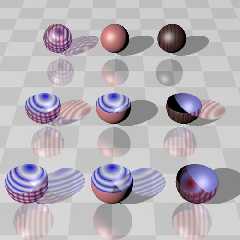|
 |
Some experiments with interior_texture, shadows and reflection
interior_texture is always blue
(exterior) texture is always red
Striped pigment is for example:
marble
color_map{
[0 color rgbf <0,0,1,.8>]
[1 color rgbf 1]
}
Plain pigment is for example:
pigment{color rgb <.25, .25, .75>}
From back to front:
Three whole spheres
Three clipped spheres (so vision and light hit an interior_texture
without coming through a texture first)
A clipped sphere with photons
From left to right:
Striped filtering pigment for interior and exterior
Striped filtering pigment for interior, plain opaque for exterior
Plain opaque pigment for interior, stripped filtering for exterior
I find the current (no photon) behaviour for shadows to be at least
unintuitive, even if it is understandable (raytracer shoot vision-rays, not
light-rays). Moreover, it is inconsistent with photons.
Is this difficult to fix and should it be fixed ?
(I "found" this while trying to get an object to be no_shadow for, and only
for, the light_source it contains, see "Help - Lost in shadows and
light_groups" in p.g)
Povingly,
Philippe
Post a reply to this message
Attachments:
Download 'inttextshadows.jpg' (26 KB)
Preview of image 'inttextshadows.jpg'

|
 |
|
 |
Philippe Debar <phd### [at] wanadoo be> wrote:
> Moreover, it is inconsistent with photons.
That's because photon rays go the the opposite directions than
shadow testing rays. From this point of view, the results are very
consistent.
Of course making the shadow test rays act in the same way as photon
rays would be more desirable.
--
#macro N(D)#if(D>99)cylinder{M()#local D=div(D,104);M().5,2pigment{rgb M()}}
N(D)#end#end#macro M()<mod(D,13)-6mod(div(D,13)8)-3,10>#end blob{
N(11117333955)N(4254934330)N(3900569407)N(7382340)N(3358)N(970)}// - Warp - be> wrote:
> Moreover, it is inconsistent with photons.
That's because photon rays go the the opposite directions than
shadow testing rays. From this point of view, the results are very
consistent.
Of course making the shadow test rays act in the same way as photon
rays would be more desirable.
--
#macro N(D)#if(D>99)cylinder{M()#local D=div(D,104);M().5,2pigment{rgb M()}}
N(D)#end#end#macro M()<mod(D,13)-6mod(div(D,13)8)-3,10>#end blob{
N(11117333955)N(4254934330)N(3900569407)N(7382340)N(3358)N(970)}// - Warp -
Post a reply to this message
|
 |




![]()